Twelve Years a Slave: An Analysis of Cinematic and Symbolic Nuances
VerifiedAdded on 2022/09/14
|6
|1485
|13
Essay
AI Summary
This essay provides a comprehensive analysis of the movie 'Twelve Years a Slave,' examining its cinematic and symbolic nuances. It delves into the film's depiction of the harrowing experiences of Solomon Northup, a free African American man kidnapped and sold into slavery. The analysis explores the barbaric practices of the slave trade, the dehumanization of slaves, and the themes of racism, separation, and resilience. The essay highlights the film's powerful portrayal of historical events, the emotional impact on the audience, and the hierarchical structure of the slave system. It discusses the treatment of slaves, including the sexual exploitation of female slaves, and the overall impact of slavery on individuals and families. The film's narrative is meticulously examined to understand its portrayal of the inhuman practices of the slave trade and the fight for freedom and dignity within the context of white supremacy. The essay uses references to support its claims, providing a detailed understanding of the movie's significance.
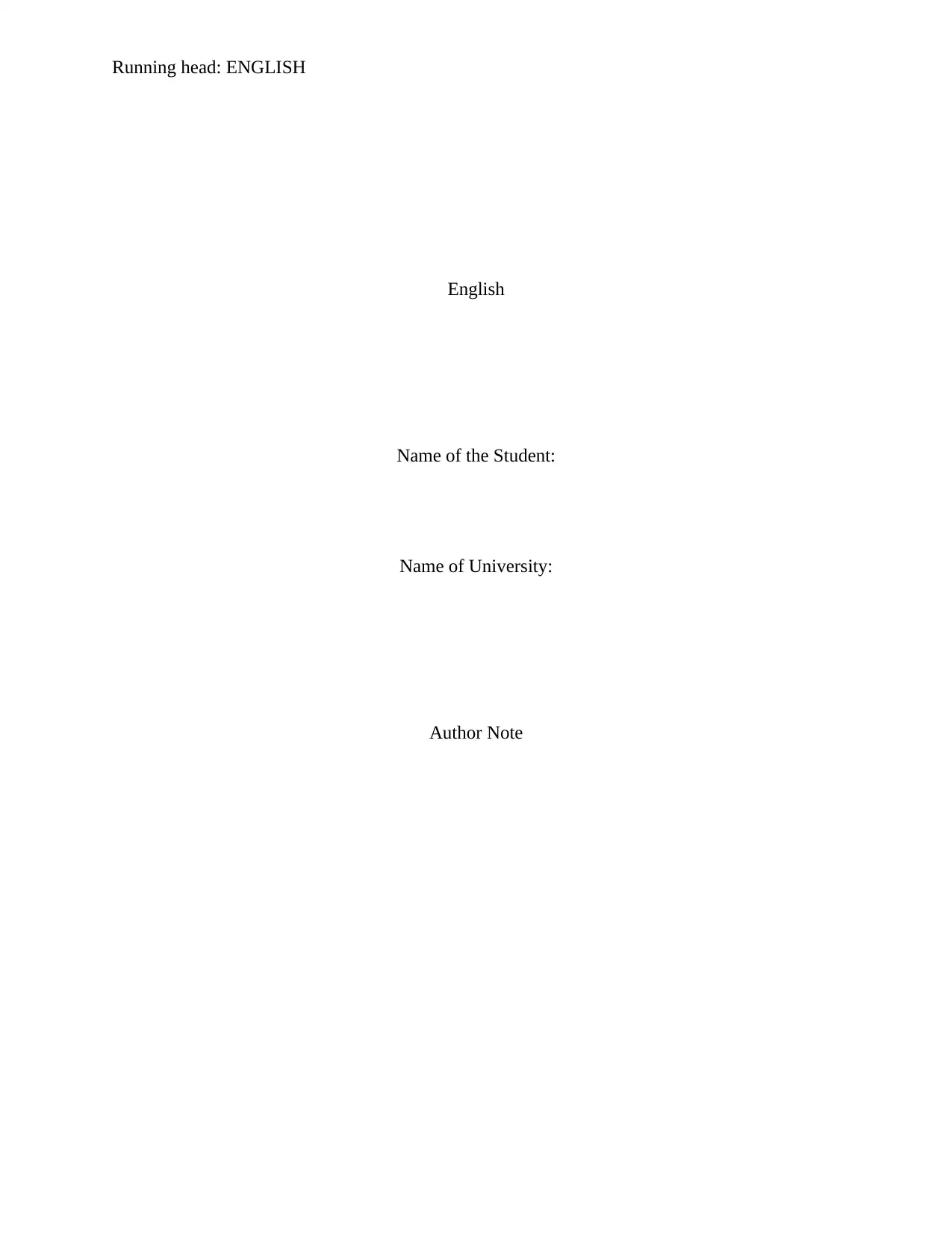
Running head: ENGLISH
English
Name of the Student:
Name of University:
Author Note
English
Name of the Student:
Name of University:
Author Note
Paraphrase This Document
Need a fresh take? Get an instant paraphrase of this document with our AI Paraphraser
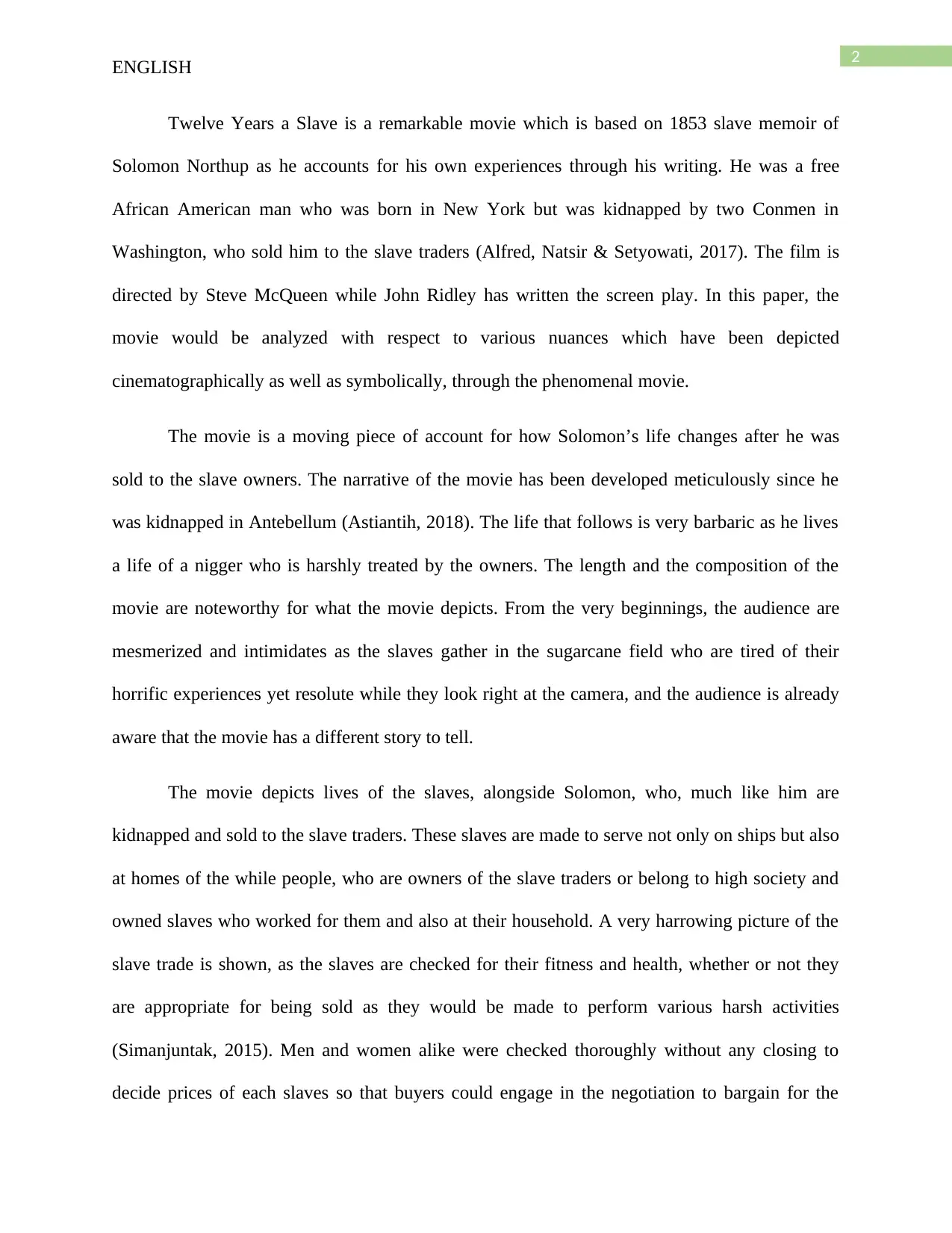
2
ENGLISH
Twelve Years a Slave is a remarkable movie which is based on 1853 slave memoir of
Solomon Northup as he accounts for his own experiences through his writing. He was a free
African American man who was born in New York but was kidnapped by two Conmen in
Washington, who sold him to the slave traders (Alfred, Natsir & Setyowati, 2017). The film is
directed by Steve McQueen while John Ridley has written the screen play. In this paper, the
movie would be analyzed with respect to various nuances which have been depicted
cinematographically as well as symbolically, through the phenomenal movie.
The movie is a moving piece of account for how Solomon’s life changes after he was
sold to the slave owners. The narrative of the movie has been developed meticulously since he
was kidnapped in Antebellum (Astiantih, 2018). The life that follows is very barbaric as he lives
a life of a nigger who is harshly treated by the owners. The length and the composition of the
movie are noteworthy for what the movie depicts. From the very beginnings, the audience are
mesmerized and intimidates as the slaves gather in the sugarcane field who are tired of their
horrific experiences yet resolute while they look right at the camera, and the audience is already
aware that the movie has a different story to tell.
The movie depicts lives of the slaves, alongside Solomon, who, much like him are
kidnapped and sold to the slave traders. These slaves are made to serve not only on ships but also
at homes of the while people, who are owners of the slave traders or belong to high society and
owned slaves who worked for them and also at their household. A very harrowing picture of the
slave trade is shown, as the slaves are checked for their fitness and health, whether or not they
are appropriate for being sold as they would be made to perform various harsh activities
(Simanjuntak, 2015). Men and women alike were checked thoroughly without any closing to
decide prices of each slaves so that buyers could engage in the negotiation to bargain for the
ENGLISH
Twelve Years a Slave is a remarkable movie which is based on 1853 slave memoir of
Solomon Northup as he accounts for his own experiences through his writing. He was a free
African American man who was born in New York but was kidnapped by two Conmen in
Washington, who sold him to the slave traders (Alfred, Natsir & Setyowati, 2017). The film is
directed by Steve McQueen while John Ridley has written the screen play. In this paper, the
movie would be analyzed with respect to various nuances which have been depicted
cinematographically as well as symbolically, through the phenomenal movie.
The movie is a moving piece of account for how Solomon’s life changes after he was
sold to the slave owners. The narrative of the movie has been developed meticulously since he
was kidnapped in Antebellum (Astiantih, 2018). The life that follows is very barbaric as he lives
a life of a nigger who is harshly treated by the owners. The length and the composition of the
movie are noteworthy for what the movie depicts. From the very beginnings, the audience are
mesmerized and intimidates as the slaves gather in the sugarcane field who are tired of their
horrific experiences yet resolute while they look right at the camera, and the audience is already
aware that the movie has a different story to tell.
The movie depicts lives of the slaves, alongside Solomon, who, much like him are
kidnapped and sold to the slave traders. These slaves are made to serve not only on ships but also
at homes of the while people, who are owners of the slave traders or belong to high society and
owned slaves who worked for them and also at their household. A very harrowing picture of the
slave trade is shown, as the slaves are checked for their fitness and health, whether or not they
are appropriate for being sold as they would be made to perform various harsh activities
(Simanjuntak, 2015). Men and women alike were checked thoroughly without any closing to
decide prices of each slaves so that buyers could engage in the negotiation to bargain for the
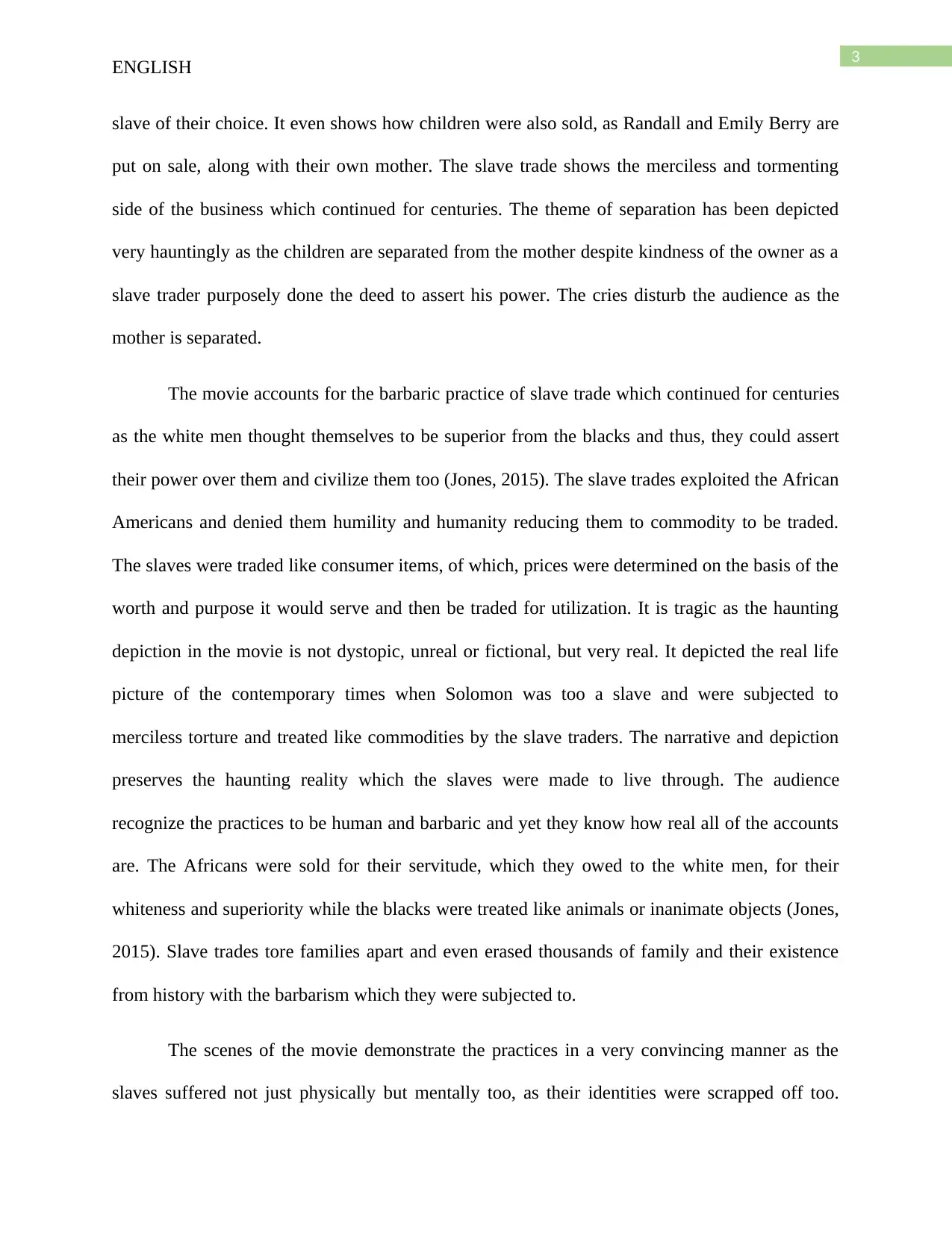
3
ENGLISH
slave of their choice. It even shows how children were also sold, as Randall and Emily Berry are
put on sale, along with their own mother. The slave trade shows the merciless and tormenting
side of the business which continued for centuries. The theme of separation has been depicted
very hauntingly as the children are separated from the mother despite kindness of the owner as a
slave trader purposely done the deed to assert his power. The cries disturb the audience as the
mother is separated.
The movie accounts for the barbaric practice of slave trade which continued for centuries
as the white men thought themselves to be superior from the blacks and thus, they could assert
their power over them and civilize them too (Jones, 2015). The slave trades exploited the African
Americans and denied them humility and humanity reducing them to commodity to be traded.
The slaves were traded like consumer items, of which, prices were determined on the basis of the
worth and purpose it would serve and then be traded for utilization. It is tragic as the haunting
depiction in the movie is not dystopic, unreal or fictional, but very real. It depicted the real life
picture of the contemporary times when Solomon was too a slave and were subjected to
merciless torture and treated like commodities by the slave traders. The narrative and depiction
preserves the haunting reality which the slaves were made to live through. The audience
recognize the practices to be human and barbaric and yet they know how real all of the accounts
are. The Africans were sold for their servitude, which they owed to the white men, for their
whiteness and superiority while the blacks were treated like animals or inanimate objects (Jones,
2015). Slave trades tore families apart and even erased thousands of family and their existence
from history with the barbarism which they were subjected to.
The scenes of the movie demonstrate the practices in a very convincing manner as the
slaves suffered not just physically but mentally too, as their identities were scrapped off too.
ENGLISH
slave of their choice. It even shows how children were also sold, as Randall and Emily Berry are
put on sale, along with their own mother. The slave trade shows the merciless and tormenting
side of the business which continued for centuries. The theme of separation has been depicted
very hauntingly as the children are separated from the mother despite kindness of the owner as a
slave trader purposely done the deed to assert his power. The cries disturb the audience as the
mother is separated.
The movie accounts for the barbaric practice of slave trade which continued for centuries
as the white men thought themselves to be superior from the blacks and thus, they could assert
their power over them and civilize them too (Jones, 2015). The slave trades exploited the African
Americans and denied them humility and humanity reducing them to commodity to be traded.
The slaves were traded like consumer items, of which, prices were determined on the basis of the
worth and purpose it would serve and then be traded for utilization. It is tragic as the haunting
depiction in the movie is not dystopic, unreal or fictional, but very real. It depicted the real life
picture of the contemporary times when Solomon was too a slave and were subjected to
merciless torture and treated like commodities by the slave traders. The narrative and depiction
preserves the haunting reality which the slaves were made to live through. The audience
recognize the practices to be human and barbaric and yet they know how real all of the accounts
are. The Africans were sold for their servitude, which they owed to the white men, for their
whiteness and superiority while the blacks were treated like animals or inanimate objects (Jones,
2015). Slave trades tore families apart and even erased thousands of family and their existence
from history with the barbarism which they were subjected to.
The scenes of the movie demonstrate the practices in a very convincing manner as the
slaves suffered not just physically but mentally too, as their identities were scrapped off too.
⊘ This is a preview!⊘
Do you want full access?
Subscribe today to unlock all pages.

Trusted by 1+ million students worldwide
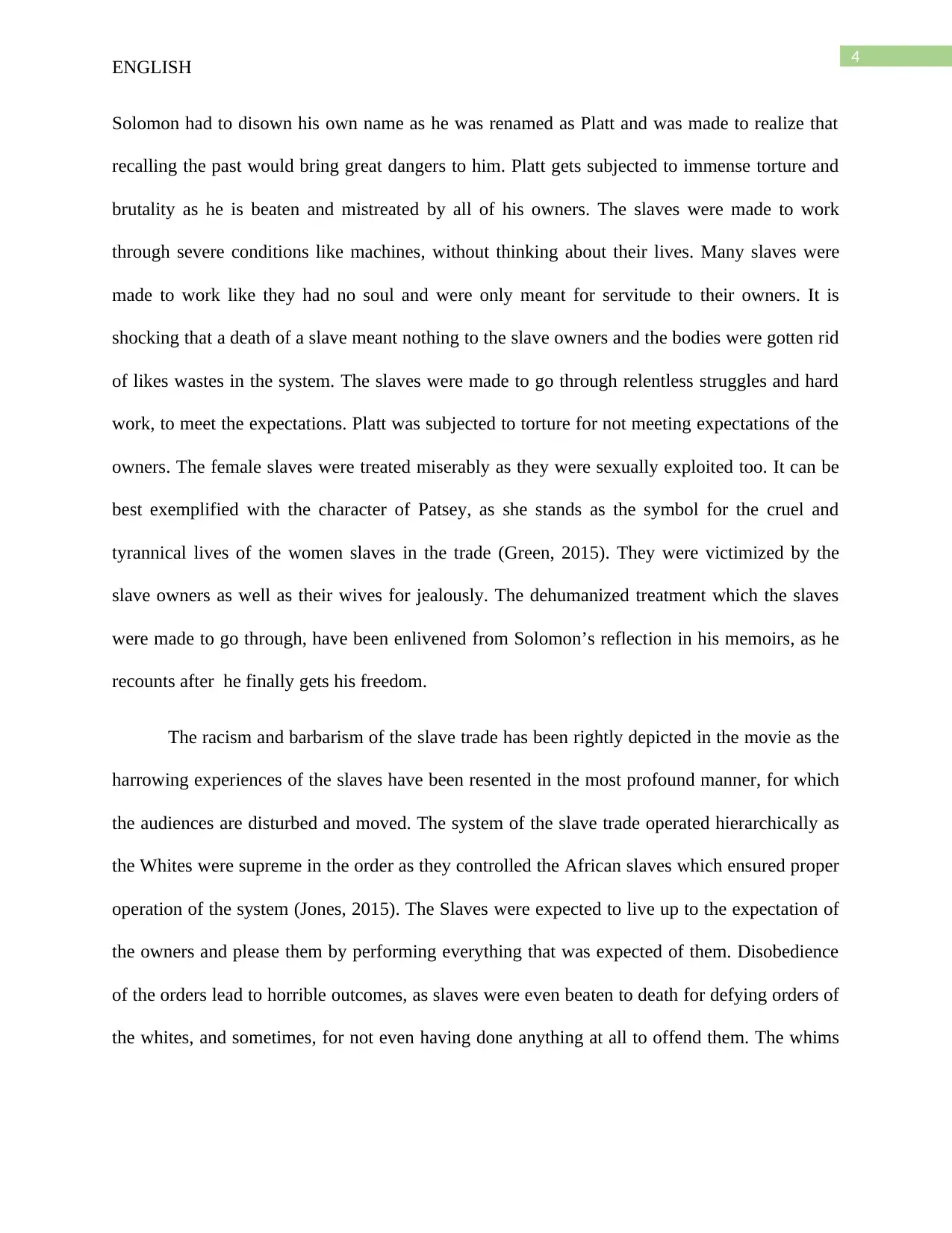
4
ENGLISH
Solomon had to disown his own name as he was renamed as Platt and was made to realize that
recalling the past would bring great dangers to him. Platt gets subjected to immense torture and
brutality as he is beaten and mistreated by all of his owners. The slaves were made to work
through severe conditions like machines, without thinking about their lives. Many slaves were
made to work like they had no soul and were only meant for servitude to their owners. It is
shocking that a death of a slave meant nothing to the slave owners and the bodies were gotten rid
of likes wastes in the system. The slaves were made to go through relentless struggles and hard
work, to meet the expectations. Platt was subjected to torture for not meeting expectations of the
owners. The female slaves were treated miserably as they were sexually exploited too. It can be
best exemplified with the character of Patsey, as she stands as the symbol for the cruel and
tyrannical lives of the women slaves in the trade (Green, 2015). They were victimized by the
slave owners as well as their wives for jealously. The dehumanized treatment which the slaves
were made to go through, have been enlivened from Solomon’s reflection in his memoirs, as he
recounts after he finally gets his freedom.
The racism and barbarism of the slave trade has been rightly depicted in the movie as the
harrowing experiences of the slaves have been resented in the most profound manner, for which
the audiences are disturbed and moved. The system of the slave trade operated hierarchically as
the Whites were supreme in the order as they controlled the African slaves which ensured proper
operation of the system (Jones, 2015). The Slaves were expected to live up to the expectation of
the owners and please them by performing everything that was expected of them. Disobedience
of the orders lead to horrible outcomes, as slaves were even beaten to death for defying orders of
the whites, and sometimes, for not even having done anything at all to offend them. The whims
ENGLISH
Solomon had to disown his own name as he was renamed as Platt and was made to realize that
recalling the past would bring great dangers to him. Platt gets subjected to immense torture and
brutality as he is beaten and mistreated by all of his owners. The slaves were made to work
through severe conditions like machines, without thinking about their lives. Many slaves were
made to work like they had no soul and were only meant for servitude to their owners. It is
shocking that a death of a slave meant nothing to the slave owners and the bodies were gotten rid
of likes wastes in the system. The slaves were made to go through relentless struggles and hard
work, to meet the expectations. Platt was subjected to torture for not meeting expectations of the
owners. The female slaves were treated miserably as they were sexually exploited too. It can be
best exemplified with the character of Patsey, as she stands as the symbol for the cruel and
tyrannical lives of the women slaves in the trade (Green, 2015). They were victimized by the
slave owners as well as their wives for jealously. The dehumanized treatment which the slaves
were made to go through, have been enlivened from Solomon’s reflection in his memoirs, as he
recounts after he finally gets his freedom.
The racism and barbarism of the slave trade has been rightly depicted in the movie as the
harrowing experiences of the slaves have been resented in the most profound manner, for which
the audiences are disturbed and moved. The system of the slave trade operated hierarchically as
the Whites were supreme in the order as they controlled the African slaves which ensured proper
operation of the system (Jones, 2015). The Slaves were expected to live up to the expectation of
the owners and please them by performing everything that was expected of them. Disobedience
of the orders lead to horrible outcomes, as slaves were even beaten to death for defying orders of
the whites, and sometimes, for not even having done anything at all to offend them. The whims
Paraphrase This Document
Need a fresh take? Get an instant paraphrase of this document with our AI Paraphraser
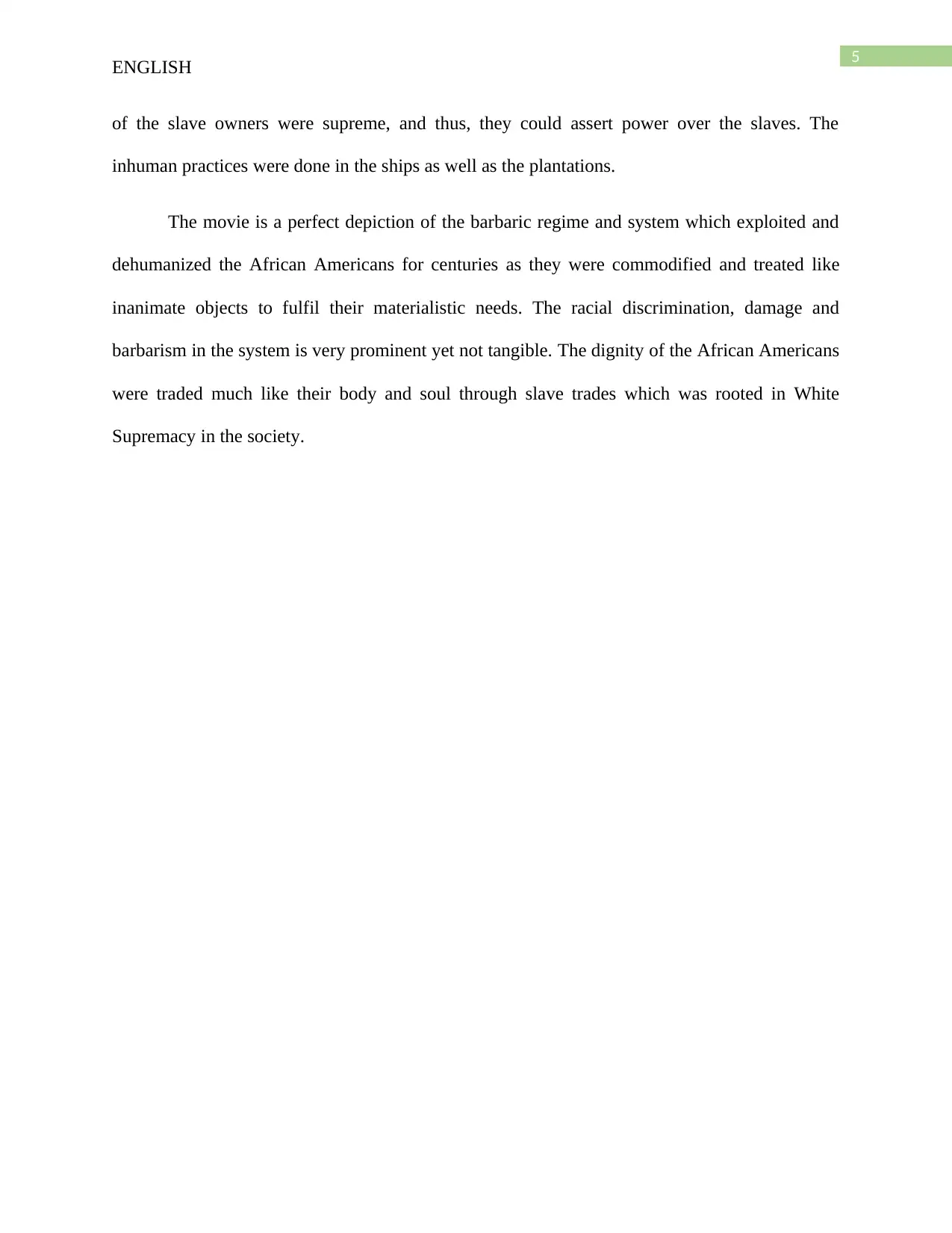
5
ENGLISH
of the slave owners were supreme, and thus, they could assert power over the slaves. The
inhuman practices were done in the ships as well as the plantations.
The movie is a perfect depiction of the barbaric regime and system which exploited and
dehumanized the African Americans for centuries as they were commodified and treated like
inanimate objects to fulfil their materialistic needs. The racial discrimination, damage and
barbarism in the system is very prominent yet not tangible. The dignity of the African Americans
were traded much like their body and soul through slave trades which was rooted in White
Supremacy in the society.
ENGLISH
of the slave owners were supreme, and thus, they could assert power over the slaves. The
inhuman practices were done in the ships as well as the plantations.
The movie is a perfect depiction of the barbaric regime and system which exploited and
dehumanized the African Americans for centuries as they were commodified and treated like
inanimate objects to fulfil their materialistic needs. The racial discrimination, damage and
barbarism in the system is very prominent yet not tangible. The dignity of the African Americans
were traded much like their body and soul through slave trades which was rooted in White
Supremacy in the society.
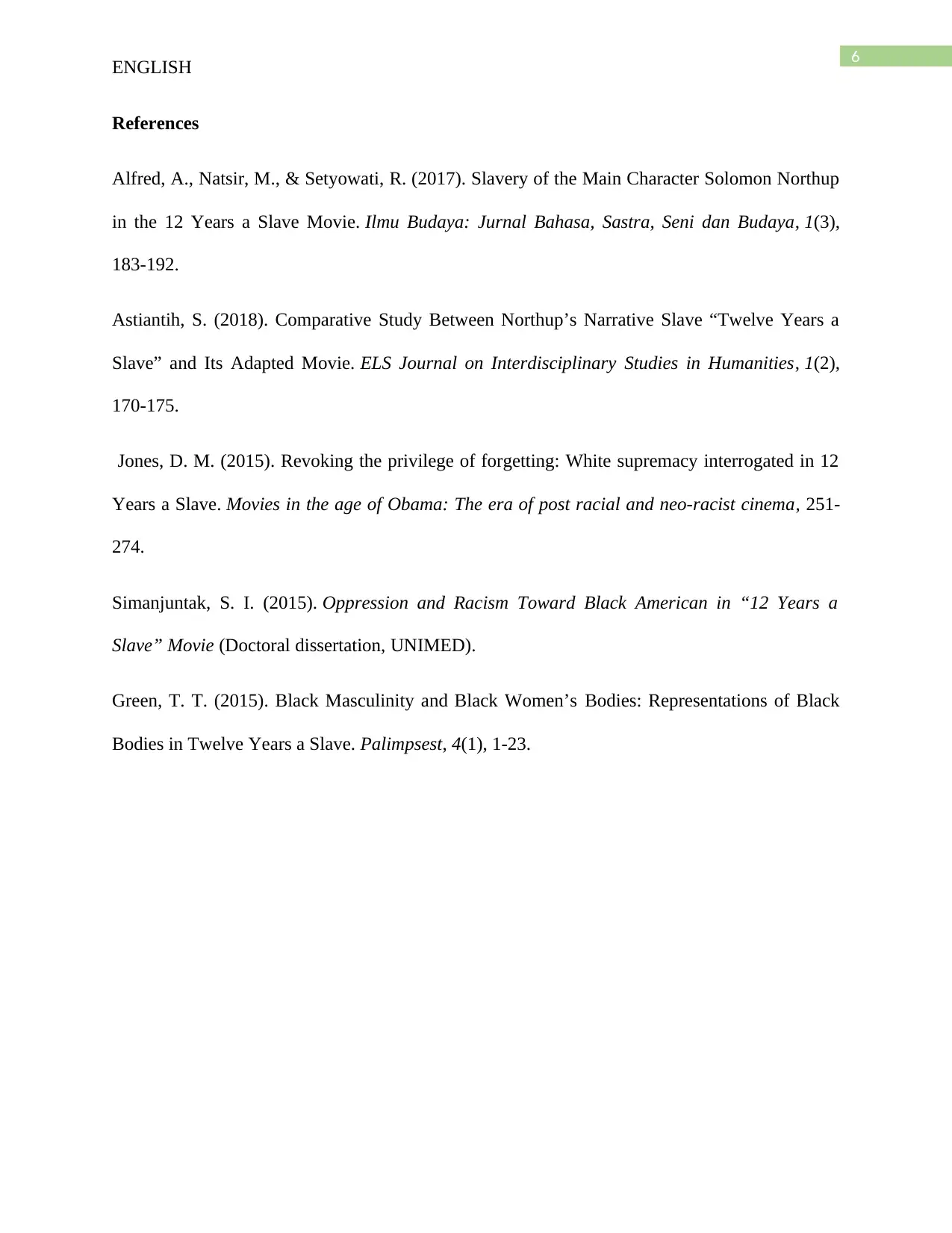
6
ENGLISH
References
Alfred, A., Natsir, M., & Setyowati, R. (2017). Slavery of the Main Character Solomon Northup
in the 12 Years a Slave Movie. Ilmu Budaya: Jurnal Bahasa, Sastra, Seni dan Budaya, 1(3),
183-192.
Astiantih, S. (2018). Comparative Study Between Northup’s Narrative Slave “Twelve Years a
Slave” and Its Adapted Movie. ELS Journal on Interdisciplinary Studies in Humanities, 1(2),
170-175.
Jones, D. M. (2015). Revoking the privilege of forgetting: White supremacy interrogated in 12
Years a Slave. Movies in the age of Obama: The era of post racial and neo-racist cinema, 251-
274.
Simanjuntak, S. I. (2015). Oppression and Racism Toward Black American in “12 Years a
Slave” Movie (Doctoral dissertation, UNIMED).
Green, T. T. (2015). Black Masculinity and Black Women’s Bodies: Representations of Black
Bodies in Twelve Years a Slave. Palimpsest, 4(1), 1-23.
ENGLISH
References
Alfred, A., Natsir, M., & Setyowati, R. (2017). Slavery of the Main Character Solomon Northup
in the 12 Years a Slave Movie. Ilmu Budaya: Jurnal Bahasa, Sastra, Seni dan Budaya, 1(3),
183-192.
Astiantih, S. (2018). Comparative Study Between Northup’s Narrative Slave “Twelve Years a
Slave” and Its Adapted Movie. ELS Journal on Interdisciplinary Studies in Humanities, 1(2),
170-175.
Jones, D. M. (2015). Revoking the privilege of forgetting: White supremacy interrogated in 12
Years a Slave. Movies in the age of Obama: The era of post racial and neo-racist cinema, 251-
274.
Simanjuntak, S. I. (2015). Oppression and Racism Toward Black American in “12 Years a
Slave” Movie (Doctoral dissertation, UNIMED).
Green, T. T. (2015). Black Masculinity and Black Women’s Bodies: Representations of Black
Bodies in Twelve Years a Slave. Palimpsest, 4(1), 1-23.
⊘ This is a preview!⊘
Do you want full access?
Subscribe today to unlock all pages.

Trusted by 1+ million students worldwide
1 out of 6
Related Documents
Your All-in-One AI-Powered Toolkit for Academic Success.
+13062052269
info@desklib.com
Available 24*7 on WhatsApp / Email
![[object Object]](/_next/static/media/star-bottom.7253800d.svg)
Unlock your academic potential
Copyright © 2020–2025 A2Z Services. All Rights Reserved. Developed and managed by ZUCOL.





